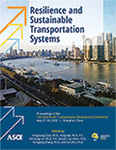13th Asia Pacific Transportation Development Conference
Analysis of Two-Wheeler Characteristics at Signalised Intersection under Mixed Traffic Conditions: A Case Study of Tiruchirappalli City
Publication: Resilience and Sustainable Transportation Systems
ABSTRACT
Two-wheelers have a substantial share of almost 40% to 50% of the total traffic mix at signalized intersections in India. Two-wheelers riding pattern is stochastic without any lane discipline or turning movement discipline at signalized intersections in Indian traffic conditions, which influences the safety and the overall traffic flow characteristics, subsequently influencing the operational efficiency of the signalized intersections. Modelling of two-wheelers’ behavior and movement are essential due to their predominant role in traffic management strategies, safety evaluation, and microscopic traffic simulations. The main aim of this study is to investigate and analyze the potential influence of the varying proportion of two-wheeler composition on the passenger car unit (PCU) of each class of vehicle at signalized intersections based on intersection clearance time of the vehicles as a measuring unit. Therefore, a highly saturated signalized intersection is chosen in Tiruchirappalli City, India, as a study site, and data is collected using video cameras during the peak hours of traffic flow. The effect of the varying proportion of two-wheelers and their turning movement in the left, straight, and right directions on PCU, is analyzed by building microscopic traffic simulation models with the field data. After simulating the microscopic models, the results indicated that with the increase in the proportion of two-wheelers composition, the PCU values of two-wheelers and three-wheelers were observed to decrease due to their lower intersection clearance time and area. On the other hand, with the increase in the proportion of two-wheelers, the PCU values of other classes of vehicles like big cars, light commercial vehicles, buses, and trucks were observed to increase due to their higher intersection clearance time and area. Hence it can be inferred that the incremental proportion of two-wheeler composition at signalized intersections has a significant influence on the PCU values of other classes of vehicles.
Get full access to this article
View all available purchase options and get full access to this chapter.
REFERENCES
Al-Kaisy, A., Hall, A. F., and Reisman, E. S. (2002). “Developing passenger car equivalents for heavy vehicles during queue discharge flow.” Transp. Res. Rec, Part A., 36(8), 725-742.
Arasan, V. T., and Arkatkar, S. S. (2010). “Micro-simulation study of effect of volume and road width on PCU of vehicles under heterogeneous traffic.” J. Transp. Eng., 136(12), 111-119. https://doi.org/10.1061/(ASCE)TE.1943-5436.0000176.
Asaithambi, G., Kanagaraj, V., Srinivasan, K. K., and Sivanandan, R. (2012). “Characteristics of Mixed Traffic on Urban Arterials with Significant Volumes of Motorized Two-Wheelers.” Transp. Res. Rec., 2317, 51-59.
Hossain, M. (2001). “Estimation of saturation flow at signalised intersections of developing cities: A micro-simulation modelling approach.” Transp. Res. Rec., Part A, 35(2), 123-141.
Indian Highway Capacity Manual (Indo-HCM) (2017). Central Road Research Institute, New Delhi, India.
Indian Roads Congress (IRC):93 (1985). Guidelines on Design and Installation of Road Traffic Signals, Indian Road Congress, New Delhi, India.
Minh, C. C., and Sano, K. (2003). “Analysis of motorcycle effects to saturation flow rate at signalised intersection in developing countries.” J. Eastern. Asia. Soc. Transp. Stud., 5, 1211-1222.
Mohan, M., and Chandra, S., (2017). “Queue clearance rate method for estimating passenger car equivalents at signalized intersections.” J. Traf. Transp. Eng., 4(5), 487-495.
Sonu, M., Dhamaniya, A., Arkatkar, S. S., Joshi, G. (2016). “Time occupancy as measure of PCU at four-legged roundabouts.” Transp. Lett: Int. J. Transp. Res., https://doi.org/10.1080/19427867.2016.1154685., 1-12 (2016).
Information & Authors
Information
Published In
Resilience and Sustainable Transportation Systems
Pages: 35 - 43
Editors: Fengxiang Qiao, Ph.D., Texas Southern University, Yong Bai, Ph.D., Marquette University, Pei-Sung Lin, Ph.D., University of South Florida, Steven I Jy Chien, Ph.D., New Jersey Institute of Technology, Yongping Zhang, Ph.D., California State Polytechnic University, and Lin Zhu, Ph.D., Shanghai University of Engineering Science
ISBN (Online): 978-0-7844-8290-2
Copyright
© 2020 American Society of Civil Engineers.
History
Published online: Jun 29, 2020
Published in print: Jun 29, 2020
Authors
Metrics & Citations
Metrics
Citations
Download citation
If you have the appropriate software installed, you can download article citation data to the citation manager of your choice. Simply select your manager software from the list below and click Download.
